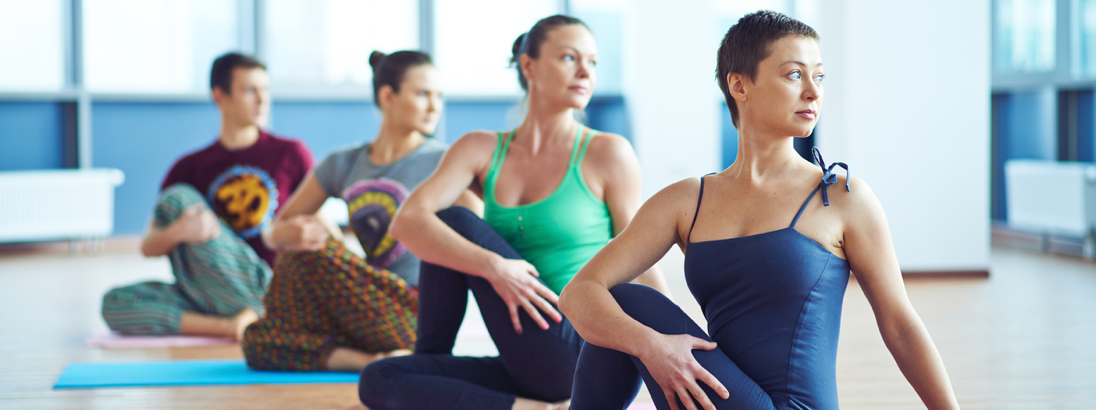Exercise and Fitness for IC and Chronic Pelvic Pain

Jill Osborne MA – ICN Founder
The question that many pelvic pain patients face when contemplating exercise is “will it help or hurt?” The evidence is overwhelming in favor of the former. Exercise can lift our spirits, reduce depression and trigger the release of endorphins, our bodies natural pain killers. Many IC/BPS patients feel that regular exercise helps to relieve their symptoms, requiring the use of fewer medications. Regular exercise also helps to decrease body weight, strengthens muscles, improves our cardiovascular health and, perhaps most importantly, helps manage stress.
Yet, more than a few IC/BPS patients have been surprised to learn that their favorite workouts and exercise routines may have contributed to their bladder and pelvic pain. Pelvic floor injuries are common triggers. Riding bicycles and spinning put an enormous amount of pressure on the pelvic floor muscles and the pudendal nerves. Known as bike rider syndrome, these patients can struggle with severe nerve pain, pins and needles and numbness in their pelvis. They will have to either change the type of saddle they are using or switch to another sport while their muscles and nerves are healing. Riding dirt bikes, motorcycles and horses can also put intense and sudden pressure on the pelvic floor muscles and nerves, especially during jumps.
If you have pelvic floor dysfunction, it’s important that you select exercises that will help rather than stress those muscles which are dysfunctional in your body. A good physical therapist should give you recommendations on exercises that you can do vs shouldn’t do depending upon which muscles have been injured. They should also measure the length of your legs. If one is shorter than the other, they may suggest using a lift in your shoe to help keep your hips level and in balance while exercising and throughout the day. Hopefully, they have also watched you walk up and down a hallway to see if you are walking normally or if there are any problems with your knees, ankles and feet.
Getting aerobic exercise is important for our heart health but if you can’t, at that moment, do the exercise that you used to do (such as spinning or running), there are several bladder and pelvic friendly exercises that can give you an excellent workout. I challenge you to try rowing, which exercises both legs and arms and builds up a great sweat. Don’t forget to use some weights to build muscle strength but, again, ask your physical therapist what is appropriate for your unique case. Dead weight lifting can put enormous pressure on the pelvic floor.
When exercising, it’s important to be respectful of that pain as an indicator that you are, indeed, hurt. Workouts must be modified accordingly and, on some days, may consist of a simple walk around the block. But, on those days when you’re feeling great, I encourage you to get out and move again.
Do’s & Don’ts
- DON’T force yourself through pain. – If you’re in a flare, don’t force a workout. A quiet walk up and down the street can lift your spirit and mobilize your body’s natural pain fighters, aka endorphins.
- DON’T continue an exercise that is provoking pain and/or discomfort in your pelvis area. – If it hurts, stop it.
- DON’T focus on one exercise for long periods of time. To avoid building muscle tension in the pelvis, upper legs and lower back, balance your workouts accordingly, focusing on aerobic and strength conditioning
- DON’T sit for long hours on hard bicycle seat – Bicycle seats are notorious for causing pelvic floor muscle and nerve discomfort, including numbness, tingling and pain.
- DO modified interval training. – Try five minute intervals using the treadmill, rower and recumbent bicycle.
- DO resistance & strength training – Even if your pelvis is tender, don’t let that keep you from working on your legs, arms independently
- DO give yourself permission to slow down – Be gentle, especially if you’re feeling pain and discomfort. Stop any exercise that is provoking pain
Exercise Ideas
Look for activities which have a smoother motion and keep the hips level with minimal jarring to the bladder and/or pelvis! Rowing, for example, is a great exercise as it puts no pressure on the crotch, does not traumatize the pelvic floor muscles and provides a great aerobic workout using both your arms and legs. Running, on the other hand, can traumatize the bladder and pelvic area through repeated impacts.
Start slowly with small intervals. If you’re in a severe IC flare, for example, pick some gentle movements that won’t traumatize your bladder. How about using some hand weights, even cans of soup, to do some arm lifts and bicep curls. When you’re ready to walk, pick a short distance close to home so that you can easily return if necessary. Some patients love walking in shopping malls or local parks with restrooms. If you can afford a membership to a gym, you won’t regret the easy access to machines, professionals and, of course, clean restrooms!
Your goal? 30 to 45 minutes a day of something that supports muscle and cardiovascular health!
- Walking – Smooth fast walking keeps your hips level yet gives you a great aerobic workout.
- Elliptical Machine – Keeps hips more level than stairmaster.
- Recumbent Bike – Avoids pressure on the pelvic floor and pudendal nerve.
- Rowing – Provides great exercise of all limbs while isolating the pelvis
- Stretch classes – Helps reduce chronic muscle tension and restores healthy blood flow
- Gentle Yoga – A popular favorite, if done without stressing the pelvic floor.
- Gentle Weights – Please avoid the machine that drives your knees in and out.
- Swimming – See note below about various strokes. Pool chemicals can also be a barrier for some. Always remove your suit and shower immediately after leaving the pool.
- Golf – Hitting balls at the course, playing 9 holes or even miniature golf!
- Bowling
- Racquet sports
Exercises that could flare symptoms:
- Single leg or double leg jumping, squatting in single leg stance, hamstring and quadriceps machines. Deep squats and lunges, which have gained tremendous popularity for those trying to enhance their booty, can be challenging. She said “When folks who have pelvic pain do squats or lunges, their hamstrings oftentimes fire instead of their gluteal muscles, which can be detrimental to a tight pelvic floor. Also, pelvic pain patients often have hip rotators that are too tight to be able to do the exercise properly.”
- Biking and spinning are a universal hard no because the bike seat compresses the pelvic floor muscles and nerves.
- Sitting abduction/adduction machines (inner/outer thigh) are known to cause pelvic pain.
- Sit-ups have a high correlation with tight pelvic floor muscles and urinary frequency and urgency.
- Deep squats with weights are associated with a greater risk of pudendal nerve injury due to the massive stretch and strain affecting the pudendal nerve.
- Running can exacerbate trigger points in hip muscles and/or can be challenging in patients with weak gluteal muscles.
- Swimming is usually a good choice however some strokes could stress various muscle groups. Stephanie wrote “The breaststroke activates the obturator internus muscle, patients with trigger points here should choose a different stroke, such as freestyle. Conversely, patients with psoas or hip flexor trigger points may get aggravated by the freestyle motion, but feel comfortable using the breaststroke. But walking in water can be a fantastic cardiovascular exercise because it gets your heart rate up but because we’re practically weightless in water, muscles and joints are free of pressure.”
- Pilates and Yoga get mixed reviews. Generally, either program should be adapted for your individual needs and fitness level.
Suggested Reading
- Exercises For Short/Tight Pelvic Floor
- Stress Urinary Incontinence in Athletes: Why You Leak When You Exercise
- As The Bicycle Turns: Cycling and the Pelvic Floor
- Finding The Right Bike Saddle For Pelvic Comfort
Updated – April 15, 2024

